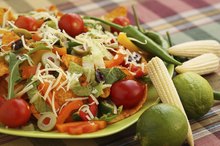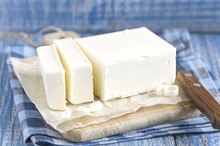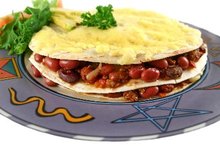Coleslaw for Diabetics
A diabetes diet is designed to help improve your diabetes health by helping to reduce blood glucose, blood pressure and cholesterol levels, as well as help you maintain a healthy weight. Some types of coleslaw, otherwise known as a cabbage salad, can fit comfortably within a nutritious diabetes diet.
Nonstarchy Vegetables
In its purest form, coleslaw is comprised of only shredded cabbage, a nonstarchy vegetable. According to the American Diabetes Association, nonstarchy vegetables should make up 1/2 of all of your lunch and dinner meals 12. A serving of nonstarchy vegetables is 1 cup raw, or 1/2 cup cooked. Eat at least 3 to 5 servings of nonstarchy vegetables every day.
- In its purest form, coleslaw is comprised of only shredded cabbage, a nonstarchy vegetable.
- A serving of nonstarchy vegetables is 1 cup raw, or 1/2 cup cooked.
Nutrition
Can Diabetics Eat Rye Bread & Pumpernickel Bread?
Learn More
Nonstarchy vegetables are healthy choices on a diabetes diet because they contain very few calories and carbohydrates. They score low on the glycemic index. This means that eating nonstarchy vegetables will probably not cause your blood glucose levels to rise significantly. A 1 cup serving of raw, shredded cabbage contains just 16 calories and In 1/2 cup of raw, shredded cabbage there is only 8 calories and 3.76 g of carbohydrate. Furthermore, raw, shredded cabbage contains 0 g of saturated fat and 0 mg of cholesterol.
- Nonstarchy vegetables are healthy choices on a diabetes diet because they contain very few calories and carbohydrates.
- Furthermore, raw, shredded cabbage contains 0 g of saturated fat and 0 mg of cholesterol.
Recipes
Like most salads, coleslaw is generally prepared with dressing, additional vegetables and spices. To keep your coleslaw diabetes- friendly, choose vinegar-based dressings over high-fat creamy dressings and use a variety of non-starchy vegetables. Try preparing an Asian coleslaw with cabbage, carrots, green onions, snow peas, sesame seeds, ginger, garlic, fresh lime juice, rice wine vinegar, and fresh ground black pepper. Or make a spicy walnut coleslaw with cabbage, carrots, red onion, Granny Smith apple slices, raw unsweetened and unsalted walnuts, Dijon mustard, spicy paprika, fresh lemon juice and fresh ground black pepper.
- Like most salads, coleslaw is generally prepared with dressing, additional vegetables and spices.
- Or make a spicy walnut coleslaw with cabbage, carrots, red onion, Granny Smith apple slices, raw unsweetened and unsalted walnuts, Dijon mustard, spicy paprika, fresh lemon juice and fresh ground black pepper.
Considerations
7-Day Menu for Diabetics
Learn More
Many prepackaged, store-bought coleslaws, or coleslaws you may order in a restaurant are prepared in a creamy mayonnaise-based dressing. These varieties of coleslaw tend to be high in calories and saturated fat, which is why they aren't the best choices for diabetics. For example, 1 oz. of regular mayonnaise salad dressing contains nearly 115 calories calories, 1.25 g of saturated fat, 7.6 mg of cholesterol, and 9,8 g of total fat.
- Many prepackaged, store-bought coleslaws, or coleslaws you may order in a restaurant are prepared in a creamy mayonnaise-based dressing.
- These varieties of coleslaw tend to be high in calories and saturated fat, which is why they aren't the best choices for diabetics.
Related Articles
References
- American Diabetes Association: Food and Fitness – Diabetes Meal Plans and a Healthy Diet
- American Diabetes Association: Food and Fitness – Create Your Plate
- United States Department of Agriculture Nutrient Database
- Cabbage, raw. FoodData Central. U.S. Department of Agriculture. Published April 1, 2019.
- NWAC diabetes self-management toolkit for Aboriginal women - fact sheet: Glycemic index. Native Women's Association of Canada. Updated 2012.
- Corliss J. Folic acid, a B vitamin, lowers stroke risk in people with high blood pressure. Harvard Health Publishing, Harvard Medical School. Updated 2015.
- Moore M. 4 types of foods to support memory. Academy of Nutrition and Dietetics. Updated 2020.
- Nosrati N, Bakovic M, Paliyath G. Molecular mechanisms and pathways as targets for cancer prevention and progression with dietary compounds. International Journal of Molecular Sciences. 2017;18(10):2050. doi:10.3390/ijms18102050
- Vitamin A fact sheets for health professionals. National Institutes of Health. Office of Dietary Supplements. Updated 2020.
- The top 10 worst foods if you have diabetes. Cleveland Clinic. Updated 2020.
- Oral allergy syndrome (OAS) or pollen fruit syndrome (PFS). American Academy of Allergy, Asthma & Immunology. Updated 2020.
- Violi F, Lip GY, Pignatelli P, Pastori D. Interaction between dietary vitamin K intake and anticoagulation by vitamin K antagonists: Is it really true?: A systematic review. Medicine (Baltimore). 2016;95(10):e2895. doi:10.1097/MD.0000000000002895
- Cabbage. University of Illinois Extension, Watch Your Garden Grow. Updated 2020.
- Cabbage. University of Maryland Extension. Updated 2020.
Writer Bio
Kathryn Gilhuly is a wellness coach based in San Diego. She helps doctors, nurses and other professionals implement lifestyle changes that focus on a healthy diet and exercise. Gilhuly holds a Master of Science in health, nutrition and exercise from North Dakota State University.









